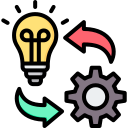In Stage 1 of this guide (Section 1.6), you were encouraged to create the initial version of your evaluation plan, using the four-stage evaluation framework for the Right Decision Service (Figure 3). This is copied below for ease of reference. It specifies short-term outcomes, intermediate outcomes, and long-term outcomes for implementation of the Right Decision Service

Planning your evaluation at the beginning of the design phase, as recommended in this guidance, ensures that evaluation goals and objectives are clearly defined and integrated into the project's overall planning and implementation process.
Starting the planning process early also allows you sufficient time to develop an evaluation plan, identify appropriate evaluation methods and tools, and secure necessary resources. Additionally, early planning enables you to identify potential challenges, and adjust the project design and implementation as needed to improve the quality and effectiveness of the evaluation.
It is important to note that evaluation planning is an iterative process that should continue throughout the project's lifecycle, with ongoing monitoring and feedback to inform and adjust evaluation plans as necessary.

